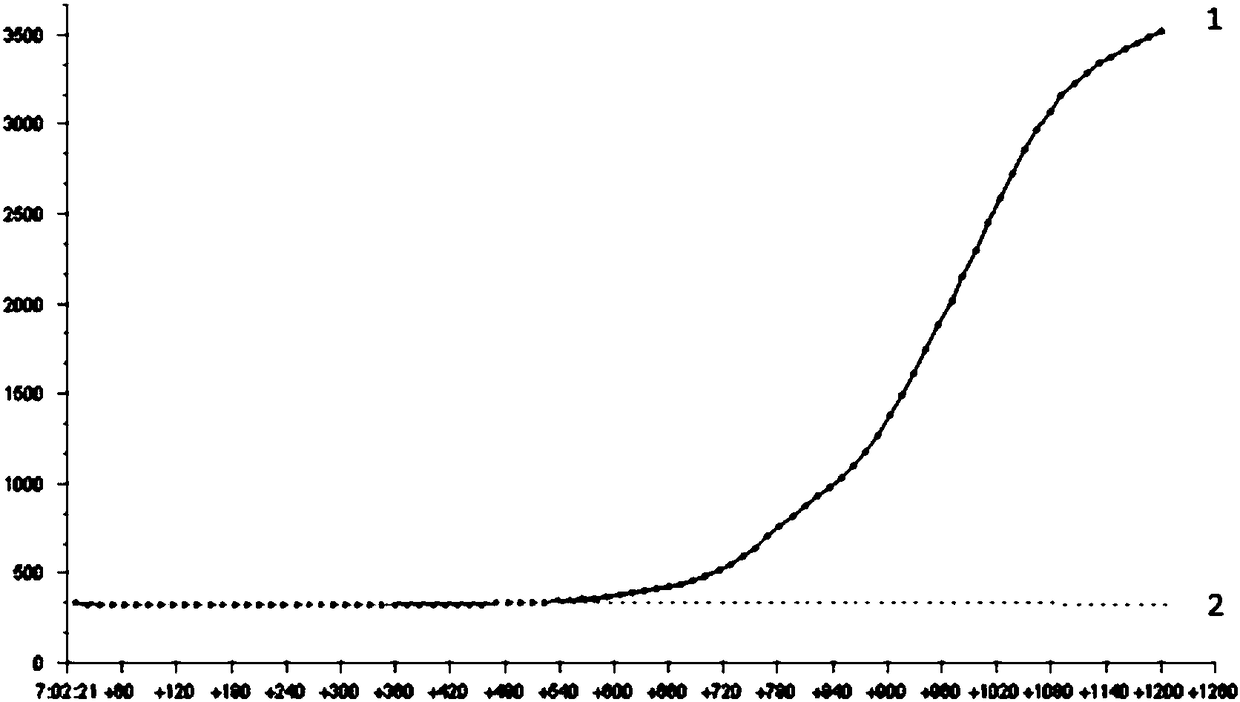RPA primer, probe and detection method for detecting salmonella
A Salmonella and probe technology, applied in the directions of microorganism-based methods, biochemical equipment and methods, DNA/RNA fragments, etc., can solve the problems of unsatisfactory target gene specificity, no application of Salmonella detection and application, etc., to facilitate promotion The effect of using and eliminating the investment of expensive equipment
- Summary
- Abstract
- Description
- Claims
- Application Information
AI Technical Summary
Problems solved by technology
Method used
Image
Examples
Embodiment 1
[0033] Selection of target genes and design and screening of RPA primers and probes
[0034] Use bioinformatics knowledge and related analysis software to analyze the common specific genes of Salmonella, such as fimA, invA, iroB, etc. By comparing these genes of Salmonella with other microorganisms, iroB is used as the target gene to be selected, and Select sequence fragments with higher specificity. Design specific primers and probes according to the design requirements of RPA for primers and probes, and then compare the sequences of the primers and probes with the species with high homology of Salmonella, and select the primers and probes with high specificity . Afterwards, a combination with high specificity and high amplification efficiency is selected through comparative analysis of the primers and probes to be selected. The sequences of the primers and probes obtained by screening are shown respectively (SEQ ID No.1, SEQ ID No.2 and SEQ ID No.3). The probe needs to be...
Embodiment 2
[0039] Establishment of RPA method for Salmonella
[0040] Inoculate Salmonella ATCC14028 into nutrient broth, place it on a shaker, and culture overnight according to the optimum growth temperature of each bacterium, draw 1mL culture solution into a 1.5mL centrifuge tube dropwise, centrifuge at 12000r / min for 2min, and discard the supernatant solution, add 500 μL sterile saline, suspend and mix well, centrifuge at 12 000 r / min for 1 min, discard the supernatant, add sterile saline repeatedly, centrifuge again, and discard the supernatant. Add 50 μL of normal saline, put in a water bath at 100°C for 10-15min, centrifuge at 12000r / min for 1min after cooling down to room temperature, and store the supernatant at -20°C for later use.
[0041]Using the DNA of Salmonella ATCC14028 as a template, set a blank control at the same time, utilize the RPA primers and probes in Example 1 to carry out RPA amplification, and use the fluorescence collection device to collect fluorescence, the...
Embodiment 3
[0045] Specific test analysis of the established RPA method
[0046] The standard strains used in this example were all purchased by Guangzhou Huankai Microbiology Co., Ltd., and the specific information is shown in Table 1.
[0047] Table 1 Strains used for RPA specificity analysis
[0048] bacteria
Source of bacteria
salmonella
ATCC14028
American Type Culture Collection
CMCC(B)50093
China Medical Microbiology Culture Collection Management Center
CMCC(B)50094
China Medical Microbiology Culture Collection Management Center
CICC21512
China Industrial Microbiology Culture Collection Management Center
CMCC(B)50071
China Medical Microbiology Culture Collection Management Center
CMCC(B)50335
China Medical Microbiology Culture Collection Management Center
...
PUM
 Login to View More
Login to View More Abstract
Description
Claims
Application Information
 Login to View More
Login to View More - Generate Ideas
- Intellectual Property
- Life Sciences
- Materials
- Tech Scout
- Unparalleled Data Quality
- Higher Quality Content
- 60% Fewer Hallucinations
Browse by: Latest US Patents, China's latest patents, Technical Efficacy Thesaurus, Application Domain, Technology Topic, Popular Technical Reports.
© 2025 PatSnap. All rights reserved.Legal|Privacy policy|Modern Slavery Act Transparency Statement|Sitemap|About US| Contact US: help@patsnap.com



